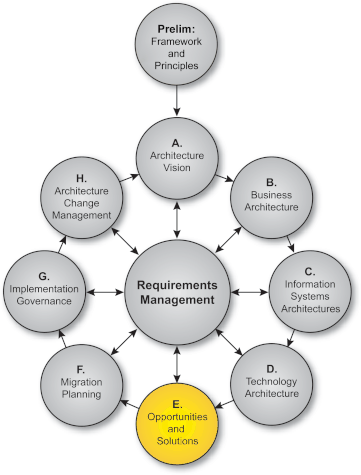
| You are here: | ||
| <<< Previous | Home | Next >>> |
This chapter is a checkpoint to verify suitability for implementation.

The objectives of Phase E are to:
Phase E identifies the parameters of change, the major phases along the way, and the top-level projects to be undertaken in moving from the current environment to the target. The output of Phase E will form the basis of the Implementation Plan required to move to the Target Architecture. This phase also attempts to identify new business opportunities arising from the architecture work in previous phases.
Sometimes the process of identifying implementation opportunities allows a business to identify new applications, and in this case it may be necessary to iterate between Phase E and previous phases. Iteration must be limited by time or money to avoid wasting effort in the search for a perfect architecture.
Phase E is the first phase which is directly concerned with implementation. The task is to identify the major work packages or projects to be undertaken.
An effective way to do this is to use the gap analysis on the business functions between the old environment and the new, created in Phase D. Any functions appearing as "new" items will have to be implemented (developed or purchased and deployed).
Slightly harder to identify are the projects required to update or replace existing functions which must be done differently in the new environment. One of the options to be considered here is leaving an existing system in place and coexisting with the new environment.
During this final step in the specification of building blocks it must be verified that the organization-specific requirements will be met. Key to this is reason checking against the business scenario driving the scope of the project. It is important to note that the ensuing development process must include recognition of dependencies and boundaries for functions and should take account of what products are available in the marketplace. An example of how this might be expressed can be seen in the building blocks example (Part IV: Resource Base, Building Blocks).
Coexistence appears on the surface to be easy. After all, the original system is left in place, largely unchanged. Unfortunately, it is not always as easy as it looks. The main problems with coexistence are:
The most successful strategy for Phase E is to focus on projects that will deliver short-term pay-offs and so create an impetus for proceeding with longer-term projects.
Inputs to Phase E are:
Key steps in Phase E include:
Examples are reduction of costs, consolidation of services, introduction of new customer services, etc.
Classify these as new development, purchase opportunity, or re-use of existing system.
The outputs of Phase E are:
The TOGAF document set is designed for use with frames. To navigate around the document:
Downloads of the TOGAF documentation, are available under license from the TOGAF information web site. The license is free to any organization wishing to use TOGAF entirely for internal purposes (for example, to develop an information system architecture for use within that organization). A hardcopy book is also available from The Open Group Bookstore as document G063.